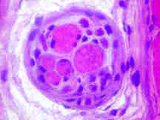 There
is quite a variety of structures throughout the body whose function
is to detect stimuli of different types and have that stimulus
initiate a nerve impulse for transmission back to the CNS. Many such
sensory receptors are little more than bare, unmyelinated axon
endings and are usually not visible histologically. Others are more
complex and are associated with CT or cellular structures. Some of
these more complex sensory strictures will be studied here.
Physiologically these receptors can be considered as chemoreceptors
or mechanoreceptors. There
is quite a variety of structures throughout the body whose function
is to detect stimuli of different types and have that stimulus
initiate a nerve impulse for transmission back to the CNS. Many such
sensory receptors are little more than bare, unmyelinated axon
endings and are usually not visible histologically. Others are more
complex and are associated with CT or cellular structures. Some of
these more complex sensory strictures will be studied here.
Physiologically these receptors can be considered as chemoreceptors
or mechanoreceptors.
Objectives
- Recognize taste buds on lingual
papillae and understand how their structure facilitates taste
perception.
- Recognize Meissner’s and
Pacinian corpuscles in the skin.
- Identify olfactory epithelium
and understand its function.
- Learn the general structure of
the organ of Corti in the inner ear and the roles of its
structural components in hearing
The examples to be studied here are "mechanoreceptors"
consisting of thin layers of connective tissue around sensory axons.
Know the histological
differences and functions of these structures.
Next comes
several specialized sensory organs. |